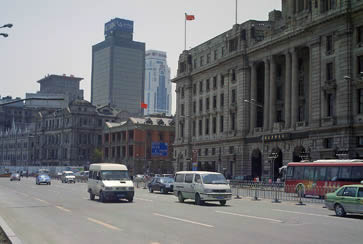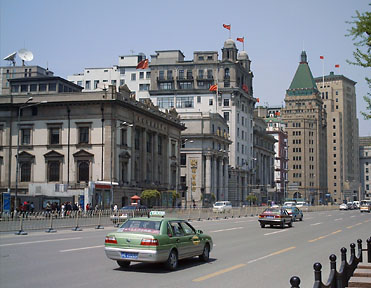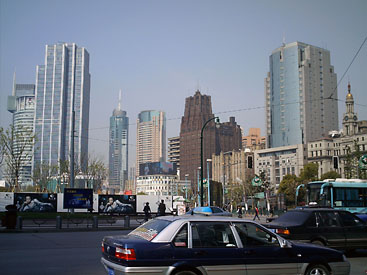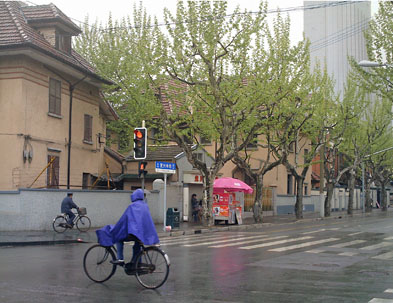I arrived in Shanghai on a dreary, wet morning last April. As my taxi crept from the airport through the heavy rain and traffic, I saw endless clusters of modern high-rise apartment buildings. Their bright hues – white, yellow, pink – looked stark against the leaden sky.
After settling in at the hotel, I noticed that the rain had stopped, so I ventured out to Zhongshan Road, an avenue that runs along the Huangpu River. Traditionally known as "the Bund", this avenue was Shanghai’s version of Wall Street a century ago, when the city was a major base for European, American and Japanese trade in East Asia. Today the Bund is still lined with the stately buildings that once housed foreign-owned banks, hotels and trading houses. At first glance, they all seem to blend into a granite phalanx punctuated by columns and domes. But a closer look reveals that they’re actually a hodgepodge of different European architectural styles – Neoclassical, Art Deco, Gothic, Romanesque, Renaissance and Beaux Arts.

 A view of some of the grand old buildings on the Bund.
Note the modern towers in the background.
A view of some of the grand old buildings on the Bund.
Note the modern towers in the background.
The well-preserved grandeur of the Bund gives a feeling of permanence, of the enduring weight of Shanghai’s history. This is a false impression. Just look up, and you’ll see how the city is changing: Several modern towers now loom over the Bund’s architectural treasures. Turn around and look across the river. On the opposite bank is a district called Pudong, which was once a rural area dotted with farms, marshes, and small factories. Today it presents a glittering skyline dominated by the Oriental Pearl TV Tower, the third highest television tower in the world.

 The skyline of Pudong, with the Oriental Pearl TV Tower in front.
The skyline of Pudong, with the Oriental Pearl TV Tower in front.
Central Shanghai is filled with glass towers, usually hotels and office buildings, along with glass-encased shopping centers containing upscale stores, cafes, and restaurants. And on every third block there’s a Starbucks. Or so it seemed.
Shanghai has experienced dizzying growth since the early 1990s. Foreign investment, private businesses, and rising personal incomes have all left their marks, especially in the form of a booming construction industry. A Chinese guide told me that the average age of the city’s buildings is only seven years. There are 4,000 high-rises, he said, already more than in New York, and plans are in the works to build 1,000 more.
A Turbulent History
Shanghai’s modernization is a result of unprecedented prosperity. The city is now filled with great restaurants, shops, galleries, clubs, and discos, easily reachable via a clean and efficient metro system. I enjoyed being in Shanghai, but couldn’t help thinking that rapid growth and modernization may be compromising its architectural heritage and unique character. As I walked around, I often fantasized about going back in time to see what Shanghai was like several decades ago.
It would certainly have been dangerous to return to the late 1960s, when Red Guards were terrorizing everyone at the height of the Cultural Revolution. Far better to turn the clock back a bit more, to before the Communist takeover in 1949, and before the Japanese occupation in World War II. The period of choice would be the 1920s or 1930s, when Shanghai’s streets were filled with the gleaming chauffeured cars of British bankers and Chinese gangsters making their way through crowds of peddlers, beggars, coolies and rickshaw-pullers. It was during these two decades that Shanghai reached its peak – and its nadir.
From its beginnings as a fishing village about a thousand years ago, Shanghai had by the 16th century become a significant port and center of commerce. When the British defeated China in the Opium War, in 1842, they won the right to govern their own district in the city, called the "International Settlement", where their citizens could live and do business under British Law. The Settlement covered most of central Shanghai, including the Bund. Not to be outdone, the French established their own "concession" just to the south. To the east of the French Concession was the original walled city, or Old Town, which remained the domain of the local Chinese. As a result of foreign commercial activity, and the influx of Chinese refugees escaping civil wars, Shanghai’s size and wealth grew exponentially.
By the 1920s, Shanghai was the commercial and financial capital of Asia, a cosmopolitan city where Western and Japanese businessmen got rich and formed a sort of colonial aristocracy. But it was also a city of corruption, crime, and poverty. Many of the Chinese were poor. So were most of the foreign refugees: White Russians fleeing the Bolsheviks and Jews fleeing the Nazis, both groups finding refuge in the one place that required no passports or visas. Shanghai didn’t only welcome exiles, but also drug dealers, con artists, spies, gunrunners, and ne’er-do-wells from around the world. The city was a heady brew of elegant hotels and restaurants, chic nightclubs, and fashionable shops…but also of brothels, opium dens, seedy bars, and gambling houses largely run by organized crime. All this didn’t completely end with the Japanese occupation. Allied nationals were sent to internment camps, but residents from Axis and neutral countries partied on. It wasn’t until the Communists arrived that the lights finally went out.
History Eclipsed
Today, a shiny new Shanghai is rising, literally, and pushing its history into the shadows. But there are many places where the old Shanghai still asserts itself. The Bund is one of them, of course. The best-known building there is probably the Peace Hotel, located at the corner of Nanjing Road, one of Shanghai’s main shopping arteries. It opened in 1929 as the Cathay Hotel, and was the last word in luxury at the time, comparable to Raffles in Singapore and The Peninsula in Hong Kong. The lobby had an Italian marble floor, Art Deco frescoes, and Lalique chandeliers. The elegant suites boasted marble bathtubs with silver taps, as well as a rare feature called "air conditioning". Waiters, maids, valets, and launderers were at the guests’ beck and call. Not surprisingly, the hotel was frequented by many celebrities. Charlie Chaplin was a guest, as were Lana Turner, George Bernard Shaw, Chiang Kai-shek, and Noël Coward, who completed his play Private Lives while recuperating from the flu there. I tried to get a look inside the hotel during my stay, but it was closed for renovations.

 Another view of the Bund. The building with the green-pyramid
roof is the Peace Hotel.
Another view of the Bund. The building with the green-pyramid
roof is the Peace Hotel.
A mile to the west along Nanjing Road is the Park Hotel, which has kept its original name. The dark brick structure’s 22 floors made it the tallest building in the Far East when it opened, in 1934. Although the lobby and rooms were completely remodeled in 1950, the lobby was again renovated in 2001 to bring back some of the old atmosphere. I don’t think the current decor faithfully reflects the original, but it is beautiful. In any case, the building itself remains a gem of Art Deco architecture. Across from the hotel is the former site of the Shanghai Racecourse, where the spring and autumn race meetings were the main events on the British social calendar. That area is now occupied by People’s Park and People’s Square, and the former Shanghai Racecourse Club is now the Shanghai Art Museum.

 Renmin (People’s) Square. The dark-red brick building in the
center is the Park Hotel.
Renmin (People’s) Square. The dark-red brick building in the
center is the Park Hotel.
To the northwest, on Anyuan Road, is an active Buddhist monastery called the Jade Buddha Temple. I enjoyed wandering through this beautiful place, taking in the bright yellow walls and red lanterns, the courtyards filled with incense, the halls where devotees prayed to gold-plated Buddha statues, and, most of all, the famous "white jade" Buddha (though it looked pale green to me). I gasped a little when I first saw the two-meter-high statue, struck by its ethereal beauty. It took me a long time before I could take my eyes off it and finally leave the special chamber where it sits.
Then there’s the Old Town, in the southeastern corner of central Shanghai. That’s where you’ll find the Yu Yuan (Yu Garden) and City Temple Market. The garden has five lovely acres of ponds, wooden pavilions, and rockeries, but my experience there was less than satisfying. The tranquility of this 16th century sanctuary was shattered by battalions of Chinese tourists coming through, led by guides with megaphones. The market is very touristy and, when I was there, oppressively crowded. I did enjoy having a look at the famous Huxinting Teahouse, set in the middle of a small lake and reachable via a zigzagging bridge. It was pretty inside, with dark-wood paneled rooms looking out onto the lake. But rather than have the overpriced tea, I opted for some delicious dumplings at the unassuming Nanxiang Steamed Bun Restaurant, just across the way.
To the west of the tourist hubbub lies a residential section of the Old Town, a sad-looking place where shabby houses face narrow lanes draped in laundry, and where the only bright colors I saw came from sidewalk fruit displays in front of a few small groceries. This was a good antidote to my nostalgia, my single-minded desire for "authenticity". But I still couldn’t totally embrace the new Shanghai.
I was happier with what I found in the French Concession. At first glance, it seemed to offer only more towers and malls. That’s because I entered the neighborhood via its main avenue, Huaihai Road, another major shopping street in Shanghai. Behind the tall buildings, however, are tree-lined side streets filled with attractive old houses, some well-maintained and others that have seen better days.

 This quiet corner in the French Concession is just a short stroll
away from busy Huaihai Road.
This quiet corner in the French Concession is just a short stroll
away from busy Huaihai Road.
The Past Recaptured
A couple of blocks south of Huaihai Road is Xantiandì (pronounced "Shintiandi"), a development similar to New York’s South Street Seaport and Boston’s Faneuil Hall. It consists of two large blocks filled with old Chinese-style buildings that have been renovated or rebuilt. The grey-bricked structures with traditional curved eaves now shelter designer boutiques and restaurants offering pricey Chinese or Continental cuisine. And there’s the inevitable Starbucks, this one an unusually large affair taking up two stories.
Nestled in a corner of this complex is the Shikumen Open House Museum. A shikumen is a kind of multi-family house unique to Shanghai, typically built in the late 19th and early 20th centuries. The museum’s exhibition rooms depict a middle-class Chinese home in the 1920s, its bedrooms and main living areas decorated with art deco furniture and Chinese antiques. The place seemed very real, down to the period movie magazines tossed on the bed stands. Xantiandì also has another museum: the house where the Chinese Communist Party was born, in 1921, under the guidance of a young activist named Mao-Zedong.
The Past Relinquished
It’s really ironic to see the C.C.P.’s birthplace located in that mecca of consumer chic, but I don’t think most Shanghainese – especially the young – would care very much. They’re too busy enjoying their new-found affluence. Not everyone is having such a wonderful time, however. There are many who have no place in the new economy, like retirees living on meager pensions and workers laid off from failing state-run enterprises, who’ve all seen the promise of lifelong security go up in smoke. For a better understanding of Shanghai’s social realities, check out the mystery novels of American writer Qiu Xaiolong. Set in Shanghai in the 1990s, his books have gripping plots and colorful characters, but they also provide insights into the dislocations caused by China’s transition to capitalism.
While I was in Shanghai, I heard plenty of commentary about how life had improved in China because of the growing economy. It reminded me of the renewed confidence many Americans must have felt in the post-war period, when they saw their standard of living rise markedly after years of depression and war. Some of it may have been government propaganda, but there did seem to be a genuine feeling in China that "these are the best of times". That may be why Shanghai is racing to the future, and letting go of its uniqueness along the way. The city is indeed becoming a richer and livelier place, but as more old houses are torn down to make way for more office towers, Shanghai is sacrificing something it will never be able to replace.